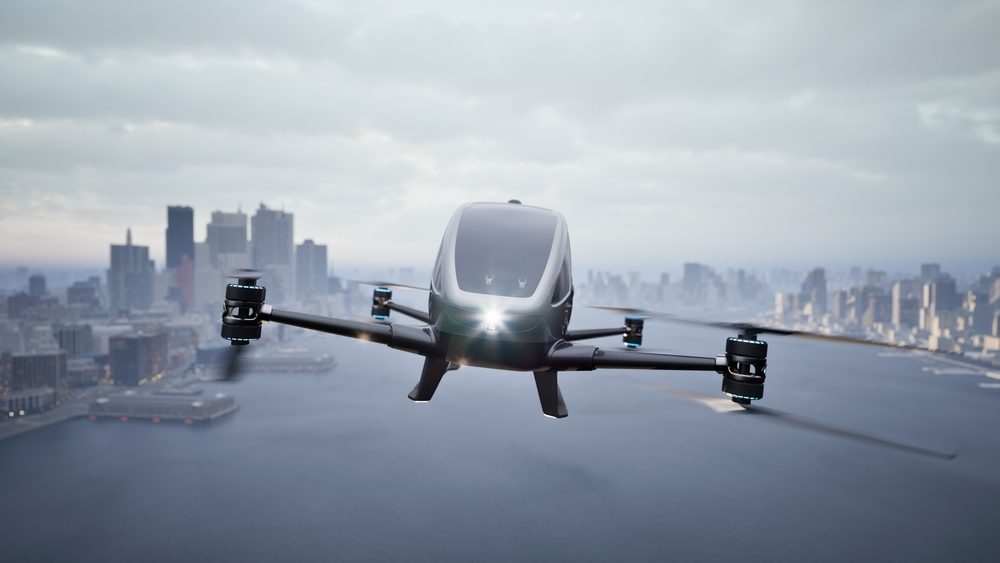Key points
- Electric vertical take-off and landing vehicles (eVTOLs) operate much like helicopters but with technological advancements that should make them safer, quieter and more environmentally friendly.
- eVTOLs are likely to be used in a wide array of use cases to improve efficiency across multiple industries and day-to-day life.
- Regulating eVTOLs so that they may properly be integrated into society will be an iterative process that should promote long-term adoption safely and effectively.
What are eVTOLS?
Are they hover cars? Flying taxis? Fancy drones? These futuristic forms of locomotion largely fall under a new and exciting category: electric vertical take-off and landing vehicles (eVTOLs). As the name suggests, eVTOLs leave from and return to the ground by moving straight up and down without the need for a runway; they most resemble helicopters. eVTOLs are meant to carry two to six passengers including a pilot, have a limited range of 30-100 miles, can reach speeds of 100 mph, and have batteries which can recharge in approximately 30 minutes.
There are several core differences between eVTOLs and helicopters. The most obvious is that eVTOLs use multiple small propulsion units powered by electricity, whereas jet fuel-powered helicopters rely on internal combustion and mechanical transmission to drive their main rotors, making eVTOLs much less harmful to the environment and people who would otherwise be exposed to emissions. eVTOLS are also quieter than traditional helicopters because they typically use lower rotor speeds than a singular rotor system of a helicopter. Furthermore, they should be safer, as design innovation has shifted from the helicopter’s single rotor to a distributed propulsion solution. With multiple rotors, eVTOLs have back-ups in case of rotor failure, which is not the case with single-rotor helicopters. Finally, rotor speed is independently controlled, thereby improving handling qualities and potentially speed over short distances. Wide adoption of eVTOLs could promote faster travel, decongestion of roadways, and exciting, clean infrastructure development.
eVTOLs have the potential to be the preferred mobility provider for short-to-medium range trips in populous areas; the long-awaited flying ‘car’ should finally become reality. While human transport is naturally considered the primary use case for eVTOLs, their potential expands into logistics, emergency services, and a host of other applications. There is a logical and reasonable future scenario in which parcels and packages, especially those that only need to move short distances, could be mass transported with eVTOLs. We believe the development, acceptance and commercialisation of eVTOLs will propel significant changes in day-to-day mobility, changing the frequency and mode with which we engage in aviation.
The path forward for eVTOLs
eVTOLs look set to be a key method of transportation in the future. There are, however, several hurdles, the largest being regulatory backing. The US Federal Aviation Administration (FAA) and other state agencies that regulate airspace across the globe must be involved in the research and development of eVTOLs to ensure they meet the required standards. Regulators will need to consider the design and capabilities of the aircraft as well as the viability of each vehicle in certain air spaces, conditions in which these vehicles may be operated, and locations where they may be housed.
On this last point, we compare the operation and logistics of eVTOLs to helicopters. Helicopters must land on helipads which, in cities, tend to be on top of buildings and on coastal shipping/landing docks. The FAA and other regulatory agencies must consider where eVTOLs will be able to take off and land within cities’ more populous areas, as this will dictate the extent to which eVTOLs may shape intra and inter-city travel. In the future, will we be able to take an eVTOL into and out of midtown New York City? What standards will eVTOLs need to comply with to fly in these potentially precarious situations? What infrastructure will be required to ensure safety? While the FAA has addressed some of these questions through the creation of ‘vertiport’ design standards in September 2022 and the first airworthiness certification criteria for an eVTOL in November 2022,[1] a plethora of questions must still be addressed, and approvals will have to be granted to promote wider adoption. Some see regulation as a barrier to eVTOLs, but we understand that proper implementation of such standards will enable better long-term outcomes for individuals and communities, as well as companies both using eVTOLs and competing for a slice of this competitive market.
Leveraging multidimensional research to project the future of EVTOLs
At Newton, we take a long-term approach to investing, which means that our idea generation and investment theses often have years of research behind them. We first brought eVTOL innovation into our long-term idea scope in 2019 when our analysts attended a conference on urban air mobility. We were surprised and excited by the long-term implications that eVTOLs could have on mobility, as well as the immense tangible market value. While we recognised that this could take several decades to achieve, we kept tabs on progress. In 2021, our private markets team met leading privately held, venture-stage eVTOL companies to update our perspectives. Since then, several of these companies have become public, demonstrating the maturity of the industry and the growing reality of everyday eVTOL use. Our continued research led to a thematic offsite in late 2022 devoted to eVTOLs, in which our research analysts briefed the wider research team on the growing market and potentially broad-reaching implications of eVTOLs in areas such as mobility, logistics, defence and infrastructure.
Our private markets team reinforced these ideas with updated data which highlighted funding progress, as well as insights and anecdotes from private eVTOL companies. With many technologies emerging, start-ups and early-stage companies can drive progress even more than large, established corporations. The private markets team seeks to develop a thesis on such technologies and young companies to better inform our active equity and multi-asset investors of the short and long-term implications for their portfolios and investible universe. To further inform our analysts and portfolio managers, our investigative research team brought in a leading eVTOL industry expert to the thematic offsite to explain his long-term thesis and provide greater depth on the current technological, competitive and regulatory landscape. As a result of our research, we now project that the first scaled commercial eVTOL operation will arrive between 2025 and 2030 and that the US eVTOL market alone could eclipse $35 billion by 2040.
When it comes to emerging industries, our multidimensional research platform helps us to harness expertise from across the breadth of our research capabilities, and we will continue to watch eVTOLs closely as the industry prepares for take-off.
Conclusion
eVTOLs offer many benefits over traditional aircraft. They can be sustainable, efficient and cost-effective, making them ideal for an array of applications. As the aviation industry continues to evolve, eVTOLs look set to play an increasingly important role in shaping the future of mobility. Taking little space to take off and land and offering quick transportation, eVTOLs could help to reduce traffic congestion in large cities. However, eVTOL technology is still in the early stages of development and commercialisation, with the potential for many more advances. We believe that the vast potential among eVTOL providers presents an exciting investment proposition.
[1] Source: US Federal Aviation Administration, https://www.faa.gov/air-taxis
This is a financial promotion. These opinions should not be construed as investment or other advice and are subject to change. This material is for information purposes only. This material is for professional investors only. Any reference to a specific security, country or sector should not be construed as a recommendation to buy or sell investments in those securities, countries or sectors. Please note that holdings and positioning are subject to change without notice.
Important information
This material is for Australian wholesale clients only and is not intended for distribution to, nor should it be relied upon by, retail clients. This information has not been prepared to take into account the investment objectives, financial objectives or particular needs of any particular person. Before making an investment decision you should carefully consider, with or without the assistance of a financial adviser, whether such an investment strategy is appropriate in light of your particular investment needs, objectives and financial circumstances.
Newton Investment Management Limited is exempt from the requirement to hold an Australian financial services licence in respect of the financial services it provides to wholesale clients in Australia and is authorised and regulated by the Financial Conduct Authority of the UK under UK laws, which differ from Australian laws.
Newton Investment Management Limited (Newton) is authorised and regulated in the UK by the Financial Conduct Authority (FCA), 12 Endeavour Square, London, E20 1JN. Newton is providing financial services to wholesale clients in Australia in reliance on ASIC Corporations (Repeal and Transitional) Instrument 2016/396, a copy of which is on the website of the Australian Securities and Investments Commission, www.asic.gov.au. The instrument exempts entities that are authorised and regulated in the UK by the FCA, such as Newton, from the need to hold an Australian financial services license under the Corporations Act 2001 for certain financial services provided to Australian wholesale clients on certain conditions. Financial services provided by Newton are regulated by the FCA under the laws and regulatory requirements of the United Kingdom, which are different to the laws applying in Australia.








Comments